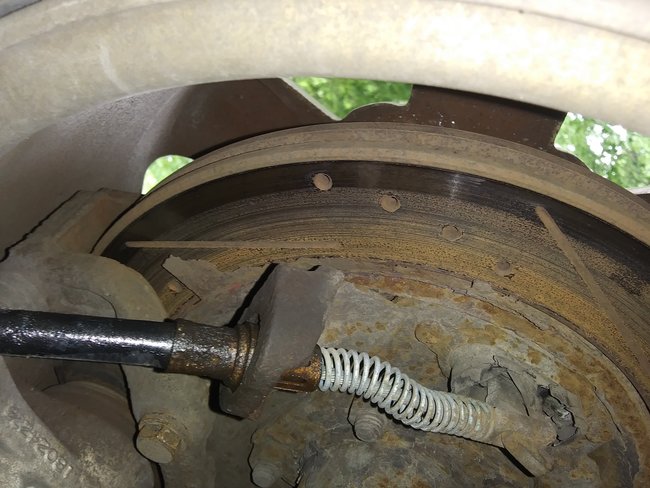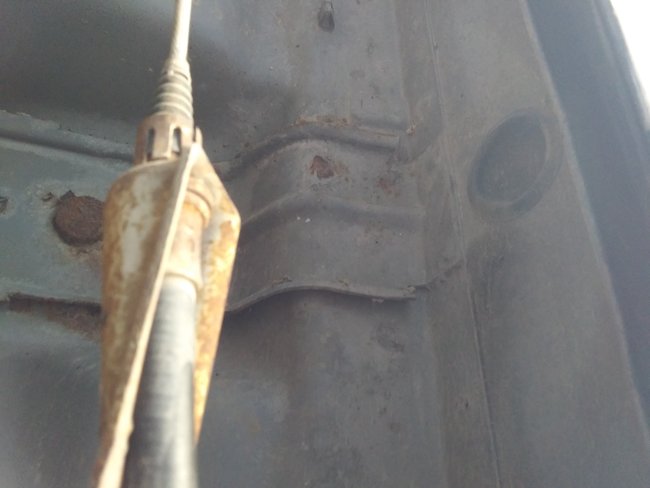Can you post a photo? Brake fluid is never involved with the parking brake. It is possible the parking brake cable and one of the brake hydraulic lines are tied together, but that would be only to physically hold them up and away from hot exhaust parts and rotating parts.
Replacing a leaking brake line is never done by installing an original part because they are way too hard to fish through the body and various brackets. That can only be done when the vehicle is coming together on the assembly line. Instead, generic replacement lines are installed in a number of ways. If the entire line is badly-rusted, look for where it's attached in front, then in back, and remove both of those ends. To save time, the old line is often left in place, then the new line can be tied to it. Replacement line is available in bulk. You buy it by the foot, slide on new soft metal nuts, then form double flares on each end. It takes some time to form the bends to follow as closely as possible the old line's routing. Often we have to route it differently where it's impossible to follow the old line, but we have to look for places that don't leave it susceptible to rocks or other debris, and it has to stay away from hot and moving parts. It also has to be anchored solidly to prevent it from vibrating or flexing. Vibration will cause the metal to "work-harden", and that leads to stress-cracking. Nylon tie straps are used most often to quickly anchor the new line to the old one or some other attaching points.
Very often a brake line only rusts out in one small area where snow, water, and road salt commonly collect. When the rest of the line is still solid and rust-free, it is faster and less expensive to cut that section out and replace just that part. Once removed, soft metal nuts are slid onto the ends remaining on the vehicle, then those ends get a double-flare. The tool for making those flares is not horribly expensive, or you can rent or borrow one from an auto parts store that borrows tools. It's best to have someone show you how to use it properly, and make some practice flares on scraps of tubing. The hardest line I've found to make double flares on is the line that comes in bulk on a big coil. Being bent into a loop weakens it on one side and often causes the flare to be of-center, and the need to cut it off and try again. I have much better luck with pieces of straight line that have never been bent or curved.
Once the old pieces of line are prepared with flares and nuts, screw on a union to each one, then install a pre-manufactured steel line. Those are available in common lengths from any hardware store or auto parts store. The most common diameter is 3/16" for cars. Take the old section with you to match up if you aren't sure. Common lengths could include 6", 12", 24", etc, up to as much as five feet. While it gets more expensive this way, you can buy two pieces that total the length you need, then piece them together with another union. You don't want to end up an inch or two too short. It's better to end up with an inch or two too much, then it can have some small s-bends added to shorten it overall until it fits.
Some hints when doing this job:
1. Use special "flare-nut" wrenches when tightening the nuts and unions. Those are all made of very soft metal and will deform and round off when using a regular open-end wrench. Flare-nut wrenches grab the nut on four corners instead of just two.
2. Absolutely do not try to use compression fittings on brake line. Those are used in plumbing where pressures don't exceed 50 to 100 psi. Under moderate braking, it is real easy for line pressure to exceed 2000 psi. Compression fittings will slide apart under that kind of pressure. To add to the insult, if the other guy runs a red light and causes a crash, his lawyer or insurance investigator will find those fittings on your car, then you can be sure they'll be all over it looking for other non-approved modifications that compromise safety, and they will use that against you in any lawsuit. A mechanic caught doing the repair this way will be fired, rather than risk involving his employer in a future lawsuit.
3. When you make a double-flare, the last step is to fold the end of the tube down on itself. Some people get carried away and crush that fold as tight as possible. Instead, just use enough pressure to form the flare, then leave it not fully-crushed. That leaves it a little room to be squeezed when you tighten the nut. That helps it form a good seal to the seat in the union.
4. Most importantly, be extremely careful to not get the slightest hint of a petroleum product mixed in anywhere there will be brake fluid. That includes penetrating oil, engine oil, power steering fluid, transmission fluid, or axle grease. When professionals work with brake parts that will contact brake fluid, they even wash their hands with soap and water to avoid contaminating the brake fluid with fingerprint grease. Petroleum product in brake fluid causes rubber parts to swell and become mushy. Once the system is contaminated, even with a single drop, the only acceptable repair is to remove every part that contains rubber that contacts brake fluid, flush and dry the steel lines, then install all new rubber-containing parts. That includes front calipers, rear wheel cylinders, all the rubber flex hoses, master cylinder, combination valve on the frame rail right under the master cylinder, and the reservoir caps. Most trucks and minivans use a rear height-sensing proportioning valve because of the passenger and cargo loading variable, and those have rubber o-rings, so that must be replaced. If the vehicle has anti-lock brakes, the hydraulic controller must be replaced. This gets to be a very expensive repair. If any part is not replaced, the contamination will leach out of it and recontaminate the new fluid.
SPONSORED LINKS
Tuesday, June 11th, 2019 AT 11:27 AM





